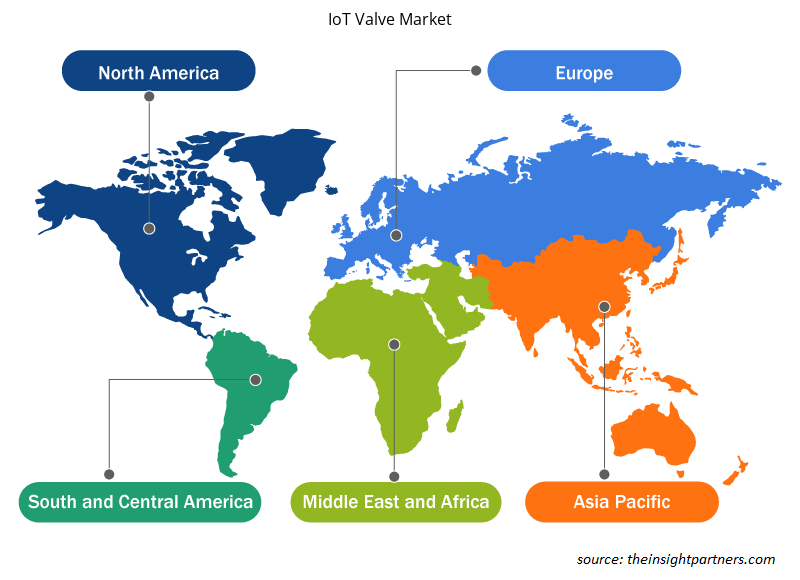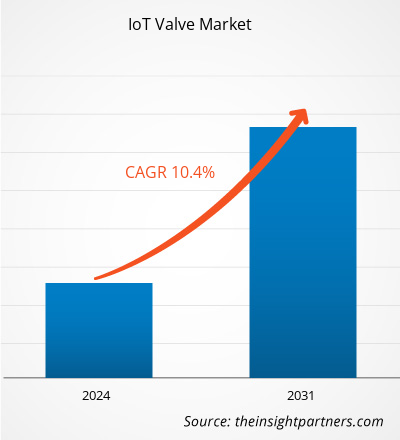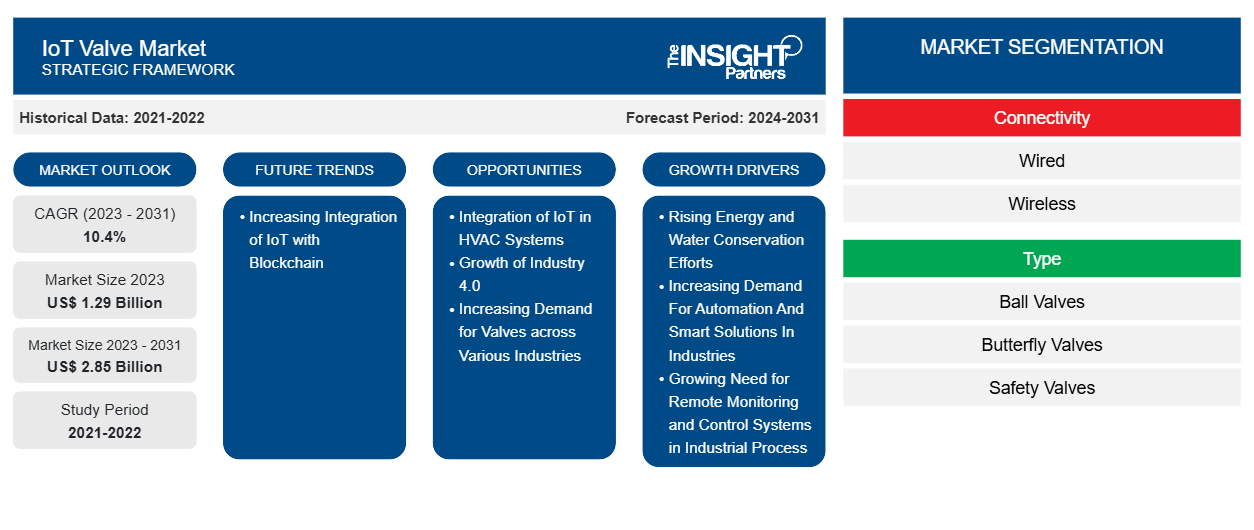IoT バルブ市場規模は、2023 年の 12 億 9,000 万米ドルから 2031 年には 28 億 5,000 万米ドルに達すると予想されています。市場は 2023 年から 2031 年にかけて 10.4% の CAGR を記録すると予測されています。今後数年間、IoT とブロックチェーンの統合の増加が主要な市場トレンドとなる可能性があります。
IoTバルブ市場分析
IoT バルブにはさまざまな用途があります。家庭や建物内の水の分配を管理し、キッチン、バスルーム、灌漑システムでの水の使用を自動制御できます。また、製造工場では、これらのバルブが液体とガスの流れを制御します。公共施設やインフラストラクチャでは、これらの IoT バルブは配水、廃水処理、ガス供給ネットワークで使用されます。
製薬、石油・ガス、化学などの分野における産業用バルブの需要と、IoT 技術の急速な進化が、IoT バルブ市場の世界的成長を牽引しています。IoT 機能を組み込むことで、バルブをリモートで制御、監視、自動化することができ、メンテナンス費用を削減し、効率を高めることができます。たとえば、IoT 技術を HVAC システムに統合することで、インテリジェント HVAC システムの使用が増え、リモートで管理および監視できるようになりました。航空宇宙、エレベーター、プロセス自動化など、さまざまな業界で IoT の採用が増えたことにより、IoT バルブの需要が高まっています。
IoTバルブ市場の概要
IoT 技術の進歩により多くの業界が変革を遂げてきましたが、最も革新的な分野の 1 つがスマート バルブの進歩です。スマート バルブは IoT 技術を使用しており、プロセス バルブ業界に並外れたブレークスルーをもたらし、さまざまなプロセスの管理とオンライン監視制御を可能にします。これにより、機械学習、最適化、安全イベントへの即時対応が可能になるほか、機器や機械の保護、デバイスの追跡、その他の顧客に合わせたメリットも得られます。スマート バルブにはスマート メーター制御システムが搭載されており、水やガスなどのリソースの正確な分配と測定が可能です。スマート メーター制御により、流量を正確に制御および監視することで無駄が削減され、リソースの使用が最適化され、パフォーマンスが向上します。スマート バルブは、リソースを効果的に利用することで、手頃な価格のソリューションを提供します。正確なガスと水の制御と分配を提供し、無駄をなくして経費を削減します。スマート バルブは、漏れを最小限に抑え、効果的な自動化を提供することで、組織がユーティリティ コストとメンテナンス コストを削減するのに役立ちます。
要件に合わせてレポートをカスタマイズする
このレポートの一部、国レベルの分析、Excelデータパックなど、あらゆるレポートを無料でカスタマイズできます。また、スタートアップや大学向けのお得なオファーや割引もご利用いただけます。
- このレポートの主要な市場動向を入手してください。この無料サンプルには、市場動向から見積もりや予測に至るまでのデータ分析が含まれます。
IoT バルブ市場の推進要因と機会
エネルギーと水の節約への取り組みの高まり
エネルギーと水の節約への取り組みの増加は、IoT バルブ市場の大きな推進力です。持続可能な慣行への世界的な注目が高まる中、政府、業界、消費者は、資源の使用を最適化するソリューションを求めています。IoT バルブは、これらの節約の取り組みにおいて、正確な制御、監視、自動化を提供します。製造工場では、IoT バルブは、さまざまなプロセスで使用される蒸気、ガス、液体の流れを調整できます。センサーとデータ分析を使用して、これらのバルブはリアルタイムの要件に基づいて流れを調整し、エネルギーの無駄を削減できます。たとえば、ボッシュは製造に IoT を活用したスマート ファクトリーを開発しています。これらの施設のセンサーは、流通チェーンから組み立てラインまで、製造手順のすべての部分に関するデータを収集します。自治体の給水システムは、IoT バルブを活用して給水ネットワークを監視および制御できます。スマート シティ プロジェクトでは、IoT バルブは給水システムの漏れを検出し、影響を受けたセクションを遮断して水の損失を防ぐことができます。また、使用パターンに基づいてさまざまなエリアの水圧を最適化し、効率的な給水を確保することもできます。政府はエネルギーと水の使用に関するより厳しい規制を実施しており、業界がスマートテクノロジーを採用するよう奨励しています。たとえば、Indian Infrastructureのレポートによると、2024年4月5日現在、インドでは16億7,500万米ドル相当の645件のスマートエネルギープロジェクトが完了し、8,530万米ドル相当の38件のプロジェクトが進行中です。これらのプロジェクトには、スマート照明、建物、計測、廃棄物管理、モビリティなど、効率的なエネルギー利用を確保するためのいくつかの要素があります。さらに、消費者は環境意識が高まり、持続可能性に貢献する製品やソリューションを求めています。
インダストリー4.0の成長
さまざまな国が、インダストリー 4.0、つまり第 4 次産業革命の実現における先駆者として広く認識されています。ドイツ政府は、インダストリー 4.0 の戦略的開発の必要性を認識し、研究開発に多額の資金を提供し、産業界と学界のパートナーシップを確立しています。政府は、産業戦略 2030 に基づき、2030 年までにドイツ経済におけるドイツ産業の付加価値総額の割合を 25% に引き上げるという目標を設定しました。
ボッシュ、シーメンス、フォルクスワーゲンなどの老舗企業を含む強力な製造基盤をさまざまな国が有しているため、インダストリー4.0産業の取り込みが増加しています。これらの企業は新技術を早期に採用し、相互運用性などのインダストリー4.0の課題に対する革新的なソリューションを生み出すために研究開発に多額の投資を行ってきました。インダストリー4.0の実装は、製造業に大きな影響を与えました。たとえば、データ分析と予知保全の使用により、企業はダウンタイムを削減し、業務の効率を向上させることができました。インダストリー4.0の採用により、バルブなどのコンポーネントにAI、IoT、センサーが統合されます。また、IoTバルブはインダストリー4.0テクノロジーと互換性があります。たとえば、Ultra Clean technologyが提供するIoTH-800シリーズは、インダストリー4.0と互換性があります。したがって、インダストリー4.0の成長は、予測期間中に世界のIoTバルブ市場の急増の機会を生み出す可能性があります。
IoTバルブ市場レポートのセグメンテーション分析
IoT バルブ市場分析の導出に貢献した主要なセグメントは、接続性、タイプ、エンド ユーザーです。
- 接続性に基づいて、市場は有線と無線に分割されます。有線セグメントは、2023 年に IoT バルブの市場シェアを拡大しました。
- タイプに基づいて、市場はエネルギーバルブ、圧力非依存制御バルブ(PICV)、および通常のバルブに分類されます。圧力非依存制御バルブ(PICV)セグメントは、2023年に最大のIoTバルブ市場シェアを占めました。
- エンドユーザーに基づいて、市場は産業用、住宅用、商業用に分かれています。産業用セグメントは2023年に最大の市場シェアを占めました。
地域別 IoT バルブ市場シェア分析
IoT バルブ市場は、北米、ヨーロッパ、アジア太平洋 (APAC)、中東およびアフリカ (MEA)、南米および中米の 5 つの主要地域に分かれています。2023 年にはアジア太平洋が市場を支配し、北米とヨーロッパがそれに続きました。
北米全域でのインターネットの普及率の高さと、主要市場プレーヤーによるデジタル技術の利用を促進し、シームレスでスムーズな業務運営と人的ミスの削減を推進する取り組みが相まって、北米全域での IoT バルブの採用が促進されています。2021 年 11 月、米国を拠点とする水沈殿物ろ過製品メーカーの Rusco は、「スマート ボール バルブ」の発売を発表しました。これらのバルブは、Android および Apple デバイスのアプリを使用して操作でき、Zigbee および Wi-Fi モデルでアクセスできます。これらは、商業用、市営、および住宅用水ろ過システム向けに作られています。このスマート バルブは、流量遮断と沈殿物のフラッシングという 2 つの基本機能を自動化します。何かが通常の操作を中断するとアプリに警告が送信され、停電時に安全な遮断が提供されるため、水ろ過システムの全体的なパフォーマンスが向上します。したがって、北米の IoT バルブ市場は、自動化と水ろ過システムのスマート ソリューションの開発が主流となっています。
IoTバルブ市場の地域別分析
予測期間を通じて IoT バルブ市場に影響を与える地域的な傾向と要因は、Insight Partners のアナリストによって徹底的に説明されています。このセクションでは、北米、ヨーロッパ、アジア太平洋、中東およびアフリカ、南米および中米にわたる IoT バルブ市場のセグメントと地理についても説明します。

- IoTバルブ市場の地域別データを入手
IoTバルブ市場レポートの範囲
| レポート属性 | 詳細 |
|---|---|
| 2023年の市場規模 | 12億9千万米ドル |
| 2031年までの市場規模 | 28.5億米ドル |
| 世界のCAGR(2023年~2031年) | 10.4% |
| 履歴データ | 2021-2022 |
| 予測期間 | 2024-2031 |
| 対象セグメント | 接続性別
|
| 対象地域と国 | 北米
|
| 市場リーダーと主要企業プロフィール |
|
IoTバルブ市場のプレーヤー密度:ビジネスダイナミクスへの影響を理解する
IoT バルブ市場は、消費者の嗜好の変化、技術の進歩、製品の利点に対する認識の高まりなどの要因により、エンドユーザーの需要が高まり、急速に成長しています。需要が高まるにつれて、企業は提供を拡大し、消費者のニーズを満たすために革新し、新たなトレンドを活用し、市場の成長をさらに促進しています。
市場プレーヤー密度とは、特定の市場または業界内で活動している企業または会社の分布を指します。これは、特定の市場スペースに、その規模または総市場価値と比較して、どれだけの競合相手 (市場プレーヤー) が存在するかを示します。
IoT バルブ市場で事業を展開している主要企業は次のとおりです。
- クリンガー・シェーネベルク有限会社
- KTWテクノロジー社
- キャリアグローバル株式会社
- IMI Plc
- シーメンスAG
- フローサーブ社
免責事項:上記の企業は、特定の順序でランク付けされていません。

- IoTバルブ市場のトップキープレーヤーの概要を入手
IoTバルブ市場のニュースと最近の動向
IoT バルブ市場は、主要な企業出版物、協会データ、データベースなどの一次調査と二次調査後の定性的および定量的データを収集することによって評価されます。市場におけるいくつかの動向を以下に示します。
- IMI plc は、Heatmiser UK Ltd. を企業価値 1 億 1,950 万米ドルで買収しました。Heatmiser の将来の財務実績に基づいて、さらに最大 860 万米ドルが追加されます。Heatmiser は IMI Hydronic Engineering (「IMI Hydronic」) の一部となりました。(出典: IMI plc、プレスリリース、2022 年 11 月)
- ウルトラ クリーン ホールディングス社は、オレゴン州ヒルズボロに拠点を置く非公開企業 HIS イノベーション グループを買収しました。HIS は、コンポーネント、プロセス ソリューション、完全統合サブシステムの設計、製造、統合を含む半導体サブファブ セグメントの大手サプライヤーです。この買収は、高品質で価値の高いソリューションのより多様なポートフォリオを顧客に提供することで、持続的で収益性の高い成長を追求するという UCT の長期戦略に沿ったものです。(出典: ウルトラ クリーン ホールディングス社、プレスリリース、2023 年 10 月)
IoTバルブ市場レポートの対象範囲と成果物
「IoT バルブ市場の規模と予測 (2021 ~ 2031 年)」では、以下の分野をカバーする市場の詳細な分析を提供します。
- IoTバルブ市場規模と予測(世界、地域、国レベルで)
- IoTバルブ市場の動向、推進要因、制約、主要な機会などの市場動向
- 詳細なPESTおよびSWOT分析
- 主要な市場動向、世界および地域の枠組み、主要プレーヤー、規制、最近の市場動向を網羅したIoTバルブ市場分析
- 市場集中、ヒートマップ分析、主要プレーヤー、IoTバルブ市場の最近の動向を網羅した業界展望と競争分析
- 詳細な企業プロフィール
- 過去2年間の分析、基準年、CAGRによる予測(7年間)
- PEST分析とSWOT分析
- 市場規模価値/数量 - 世界、地域、国
- 業界と競争環境
- Excel データセット
最新レポート
お客様の声
購入理由
- 情報に基づいた意思決定
- 市場動向の理解
- 競合分析
- 顧客インサイト
- 市場予測
- リスク軽減
- 戦略計画
- 投資の正当性
- 新興市場の特定
- マーケティング戦略の強化
- 業務効率の向上
- 規制動向への対応























 無料サンプルを入手 - IoTバルブ市場
無料サンプルを入手 - IoTバルブ市場